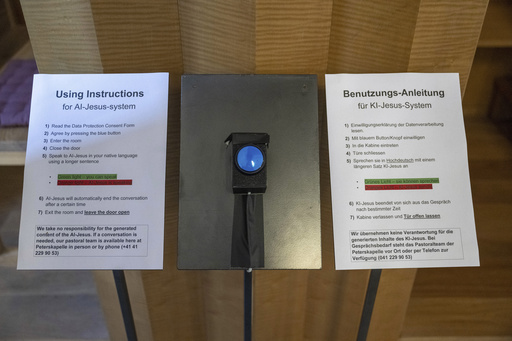
LUCERNE, Switzerland — Would you consider sharing your most profound thoughts with an “AI Jesus”? This intriguing question lies at the heart of an innovative project recently evaluated at a Catholic chapel in Switzerland. Researchers, along with religious leaders, unveiled the results of a two-month experiment, which allowed visitors to engage with a virtual avatar of Jesus. This digital incarnation was situated in a confessional and took inquiries about faith, ethics, and personal dilemmas, responding with insights derived from Scripture.
The initiative, according to the chapel’s theological coordinator, aimed to acknowledge the increasing role of artificial intelligence in our lives, particularly in religious contexts, while examining how much trust people are willing to place in a machine. Following the completion of the “Deus in Machina” exhibition at Peter’s Chapel, which commenced in late August, approximately 900 interactions were recorded, with many attendees returning for multiple visits. The project organizers reported that the experience left many participants reflective and moved, finding the interface user-friendly.
A small notice prompted visitors to enter the confessional, chosen for its intimate setting. Behind a lattice panel, a green light indicated when it was their turn to speak; a red light signaled when the “AI Jesus” was generating a response on the adjacent screen. A brief pause for AI processing was often necessary, highlighting the complexities behind the technology. Almost 300 visitors participated in a survey after their experience, contributing to the insights shared in the report.
Discussions explored an array of topics, including love, loneliness, war, suffering, the divine, and pressing issues such as sexual abuse within the Catholic Church, and its stances on homosexuality. Despite the majority identifying as Christian, the confessional was also visited by agnostics, atheists, and individuals from other faiths, including Islam and Buddhism, as noted in the project summary by the Lucerne Catholic parish. About one-third of the visitors spoke German, but “AI Jesus” also engaged in conversations in around 100 languages, encompassing Chinese, English, French, Hungarian, Italian, Russian, and Spanish.
The chapel’s theologian, Marco Schmid, who led the initiative, remarked on how seriously participants interacted with the AI, noting that humor was not the focus of these discussions. The demographic was mostly individuals aged between 40 and 70, revealing that Catholics generally found the experience to be more thought-provoking than Protestant visitors, according to the findings. Schmid emphasized that the “AI Jesus” was not designed to replace human interaction or confessions but rather to inspire contemplation on the merging of digital technology and faith.
The Catholic Church, from the Vatican level down, has been grappling with the implications—both challenges and opportunities—brought forth by the surge in public interest in AI since platforms like ChatGPT entered the scene two years ago. The Vatican has even designated a friar from a Franciscan order as its leading authority on AI, and last year, a Lutheran church in Bavaria shared sermons delivered by a chatbot. In his annual peace message, Pope Francis advocated for a global treaty to ensure the ethical conduct of AI technologies.
Haslbauer, an IT expert associated with the Lucerne University of Applied Sciences and Arts, expressed awareness of the mixed public sentiment surrounding the project, noting critical responses on social media branding it as “blasphemous” or “the work of the devil.” “Observing the internet comments can be daunting,” admitted Haslbauer, whose own appearance influenced the design of the digital Jesus.
During a live demonstration of the technology, Haslbauer asked the AI about its message for a troubled world and whether it could help individuals connect with God. “All knowledge and wisdom ultimately come from God,” the avatar voiced soothingly after processing the query, as the image flickered briefly. “If used wisely, AI can indeed be a tool for exploring the marvels of creation, deepening our understanding of Scripture, and fostering connections among individuals.” It also underscored the necessity of seeking God with genuine intent beyond the confines of technology.
Kenneth Cukier, a journalist and AI specialist with the nonprofit organization “AI and Faith,” commented that if “AI Jesus” aids individuals in making deeper connections with themselves and the world around them, then it is undoubtedly beneficial. “It could lead to improved individuals and a better society,” he suggested, but also noted a concern that it risks distancing users from more meaningful and authentic spiritual experiences.
For Schmid, this exhibition was a preliminary endeavor, and he does not anticipate an immediate reappearance of “AI Jesus.” “We were aware it was intended for a limited timeframe,” he noted, adding that any potential revival would require thoughtful consideration. “We are discussing ways to potentially reintroduce it,” he mentioned, highlighting interest from various stakeholders, including parishes, educators, and researchers as media coverage of the project spread beyond Switzerland. “Many are eager to engage with this AI Jesus, so we find ourselves in a position to reflect on how to proceed.”
